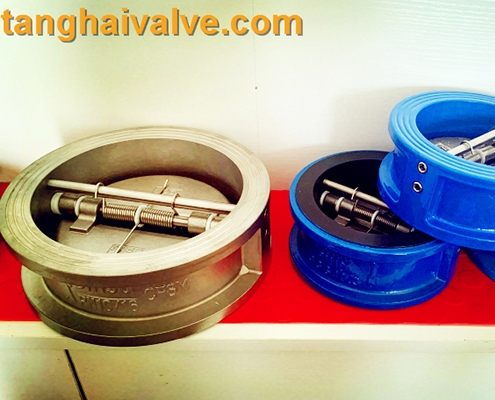The difference between one-way valve and check valve
One-way valve means that the fluid can only flow along the water inlet, and the medium at the water outlet

double-wing-check-valve-3
cannot return. Used in hydraulic systems to prevent reverse flow of oil or pneumatic systems to prevent reverse flow of air. Check valve refers to a valve whose opening and closing parts are circular discs and rely on its own weight and medium pressure to generate actions to block the back flow of the medium. It is an automatic valve.
There are two types of check valves: straight-through and right-angle. The straight-through check valve is installed on the pipeline with a threaded connection. Right-angle check valves have three forms: threaded connection, plate connection and flange connection. Hydraulic control check valve is also called lock valve or pressure maintaining valve. It is the same as check valve to prevent reverse flow of oil. However, when the oil flow is required to flow in the reverse direction in the hydraulic circuit, the oil pressure can be controlled to open the one-way valve so that the oil flow can flow in both directions. The hydraulic control check valve adopts a conical valve core, so the sealing performance is good. When the oil circuit is required to be closed, this valve can be used as a one-way locking of the oil circuit to maintain pressure. There are two types of hydraulically controlled check valve to control oil leakage: internal leakage and external leakage. The internal drain type can be used in the oil circuit where the oil flow reverse outlet has no back pressure; otherwise, the external drain type is required to reduce the control oil pressure.
The check valve can also be used to supply the auxiliary system whose pressure may rise above the system pressure. Check valves can be divided into swing check valves (rotating according to the center of gravity) and lift check valves (moving along the axis). The function of this type of valve is to only allow the medium to flow in one direction and prevent the flow in the opposite direction. Usually this kind of valve works automatically. Under the action of the fluid pressure flowing in one direction, the valve flap opens; when the fluid flows in the opposite direction, the fluid pressure and the self-coincidence of the valve flap act on the valve seat, thereby cutting off the flow.
One-way valve is a directional control valve in which air flow can only flow in one direction but not in the reverse direction. Its working principle is the same as the hydraulic one-way valve. Compressed air enters from port P, overcomes the spring force and friction force to open the one-way valve port, and the compressed air flows from P to A; when there is no compressed air at port P, it will be under the action of spring force and remaining force of port A (cavity) ; The valve port is in the closed state, so that the air flow from A to P is blocked. The one-way valve is used in occasions where the air flow is not allowed to flow in the opposite direction. For example, when the air compressor is inflating the air tank, a one-way valve is set between the air compressor and the air tank to prevent the air tank when the air compressor stops working. The compressed air in the air flow is returned to the air compressor. One-way valves are often combined with throttle valves and sequence valves to form one-way throttle valves and one-way sequence valves.
Check valves have a wide range of uses, and there are many types. The following are the check valves commonly used in water supply and heating:
1. Spring type: the liquid is from bottom to top, and the valve clack controlled by the spring is pushed up by the pressure. After the pressure disappears, the spring force pushes down the valve clack to seal the liquid back flow. Often used for check valves with small diameters.
2. Gravity type: Similar to spring type, it is closed by the gravity of the valve disc to prevent backflow.
3. Swing type: The liquid flows directly through the valve body, and the rotating disc on one side is opened by the pressure. After the pressure is lost, the disc relies on its own weight to return to the position, and the reverse liquid pressure closes the disc.
4. Plastic diaphragm type: Both the shell and the diaphragm are plastic. The general shell is ABS, PE, PP, NYLON, PC. The diaphragm includes silicone resin, fluororesin, etc.
In general, the check valve and the check valve are basically the same thing, but there are some differences. The check valve is a controlled check valve, and the check valve is a non-controlled check valve. That is to say, the one-way valve is used to provide pressure, and its main function is to maintain pipeline pressure. Although the check valve can also provide this function, it is mainly used to control the return of the medium and does not require pressure.
The above is about the difference between check valve and check valve. In fact, a check valve is only one type of valve, and a oneway valve is only a type of check valve. It is only a one-way open-close valve that prevents backflow of fluid in various pipelines or equipment. Check valves have a wide range of uses.
Related news /products:
The principles and difference between one-way valve and check valve;
The difference between globe valve and check valve;
Working principle diagram of three-way valve;
Valve actuator / actuation -(3)-classifications;



 © Copyright 2020 Tianjin Tanghaidongyang Valve Co., Ltd. All Rights Reserved.
© Copyright 2020 Tianjin Tanghaidongyang Valve Co., Ltd. All Rights Reserved.